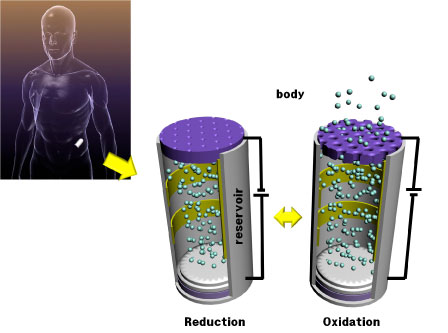| Posted: Feb 10, 2011 | |
Electrically triggered drug release from smart nanomembranes |
|
| (Nanowerk Spotlight) Numerous serious medical conditions – such as cancer, diabetes and chronic pain – require medications that cannot be taken orally, but must be dosed intermittently, on an as-needed basis, and over a long period of time. Controlled and long-term drug release has been recognized as one of the most promising biomedical technologies for certain types of chronic diseases. | |
| Controlled-release drug delivery techniques use various responsive materials and stimuli such as an implanted heat source or electronic chip to trigger the drug release from the implanted reservoir. Previously, we also reported on a magnetically triggered nanocomposite system ("Remote-controlled nanocomposite for on-demand drug delivery inside the body"). | |
| "Among many actively controlled stimuli for pulsatile drug delivery, the electrical signal would be the best source because it is portable and does not need large or special equipment to trigger it," Jin Kon Kim tells Nanowerk. "The signal can also be easily and on-demand controllable, and long cycles are possible. Furthermore, when a sensor or microchip system is combined, the feedback and remote control outside the body is possible." | |
| He cautions, though, that pulsatile drug delivery devices using electrical stimuli reported previously have several disadvantages such as 1) limited amount of loaded drug in the reservoir, 2) limited number of switching times, 3) difficulty to control accurate release amount of drug, and 4) complicated fabrication (many steps). | |
| Kim, a professor in the Department of Chemical Engineering, and director of National Creativity Research Initiative Program for Block Copolymer Self Assembly at Pohang University of Science Technology (POSTECH) in South Korea, and his team have now developed a new drug delivery device for pulsatile and on-demand drug release based on electrically actuatable nanoporous membranes made of polypyrrole (PPy). | |
 |
|
| The electrically actuable nanoporous membranes in an implant. Left: At the reduction state, the nanopores are closed due to the expansion of the PPy; thus the drugs in the reservoir could not be released. Right: At the oxidation, the nanopores are open, so that the drugs are released. (Image: Dr. Kim, POSTECH) | |
| Reporting their findings in the January 31, 2011, online edition of NANO Letters ("Electrically Actuatable Smart Nanoporous Membrane for Pulsatile Drug Release"), the POSTECH team shows that pore size of their PPy-based nanoporous membrane was reversibly actuated by the electrochemical state and that a pulsatile release of a model drug was possible. | |
| "The best way to achieve pulsatile release of drugs based on electric stimulus for an extended period is to release drugs through the nanoporous membrane with uniform pore sizes from a depot system containing large amounts of drugs for the release during extended periods" explains Kim. "This is because the pore size could be actuatable with electrical signals when a nanoporous membrane made of electrically responsive polymers is used." | |
| The researchers fabricated an electrically responsive nanoporous membrane based on polypyrrole doped with the dodecylbenzenesulfonate anions (PPy/DBS) that was electropolymerized onto the top and upper side wall of anodized aluminum oxide membrane. | |
| Kim notes that the rationale for choosing PPy/DBS as the electrically responsive material is that it exhibits a very large volume change (up to 35 vol%) depending on the electrochemical state and excellent biocompatibility. | |
| "The driving potential is less than 1.1 volts, which is sufficiently lower than that (3 volts) used for the operation of an artificial heart," he says. | |
| The nanopores in the membrane can be controllable down to nanometer scale depending on electrochemical states (oxidation vs reduction states). At the reduction state, the nanopores were closed due to the expansion of the PPy; then the drugs could not be released. The nanopores are open at the oxidation state, which allows the drugs to be released. Each state is reversible more than 1000 times, and the switching time is very short, less than 10 seconds. | |
| Since this device could be used for intermittent or on demand drug delivery, it can be applied to new therapeutic methods of hormone related diseases such as infertility, dwarfism, osteoporosis and diabetes, as well as chronic disease such as insomnia, angina pectoris, asthma and pain control, all of which require discontinuously and fast administered drug delivery. | |
| So far, Kim's team has demonstrated the drug release of their system only in in vitro conditions. In vivo experiments will be required to apply this drug delivery system in clinical trials. This still requires the development of a suitable microchip system with micro circuit, power source and controller. | |
| Although an implant system has many advantages, surgery still needs to be performed to put it in the body or to remove it after the completion of drug delivery. Kim says that at least the second surgical procedure could be eliminated if the implant is made of biodegradable polymers. | |
 By
Michael
Berger
– Michael is author of three books by the Royal Society of Chemistry:
Nano-Society: Pushing the Boundaries of Technology,
Nanotechnology: The Future is Tiny, and
Nanoengineering: The Skills and Tools Making Technology Invisible
Copyright ©
Nanowerk LLC
By
Michael
Berger
– Michael is author of three books by the Royal Society of Chemistry:
Nano-Society: Pushing the Boundaries of Technology,
Nanotechnology: The Future is Tiny, and
Nanoengineering: The Skills and Tools Making Technology Invisible
Copyright ©
Nanowerk LLC
|
|
|
Become a Spotlight guest author! Join our large and growing group of guest contributors. Have you just published a scientific paper or have other exciting developments to share with the nanotechnology community? Here is how to publish on nanowerk.com. |
|
